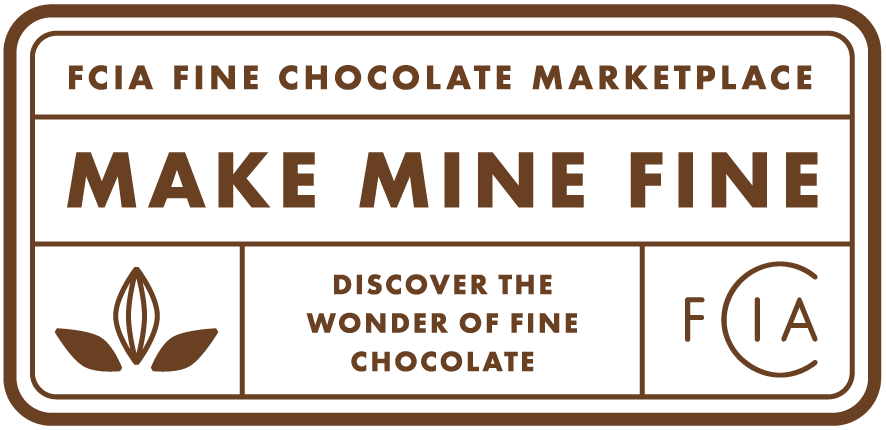At a Glance
- Population: 17.5 million
- Capital: Quito
- Rural population: 18.6%
- Cacao production: 313.284 tons / year
- Production ranking: 3rd place
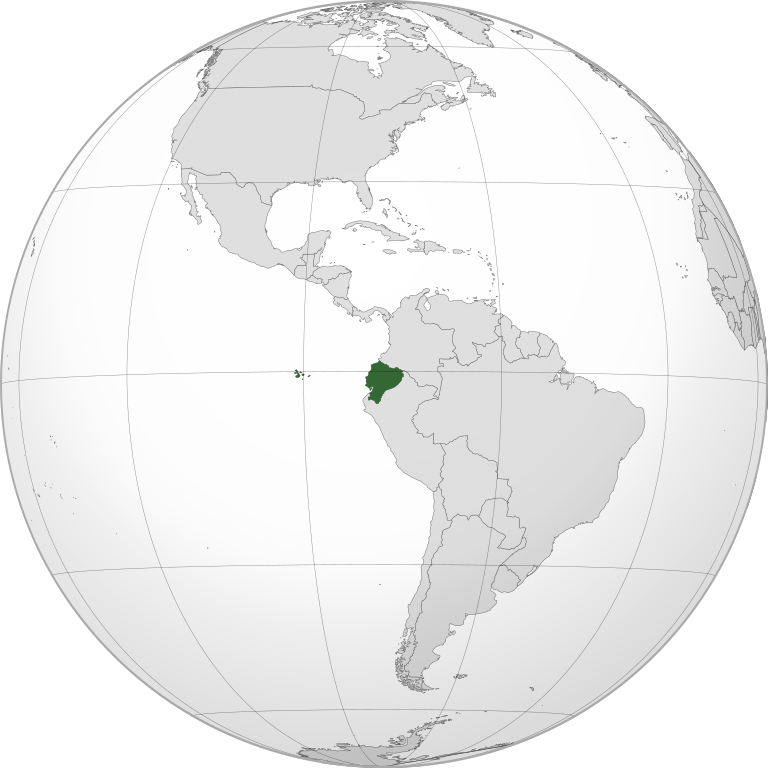
Image credit: Wikimedia
History of Cocoa
The history of cocoa in Ecuador represents a long tradition of production, a legacy of practices and knowledge transmitted from generation to generation. Recent studies show the early presence of a variety of Theobroma cacao, and its cultivation and consumption by people who lived in the south of eastern Ecuador 5,000 years ago, positioning the current province of Zamora Chinchipe as the center of origin of the domestication of cocoa.
During colonial times, in what is now Ecuadorian territory, the first wave of large exports was registered between 1790 and 1842. Since the 17th century, shipments of 34,000 loads a year were regularly sent to Mexico, specifically to Acapulco.
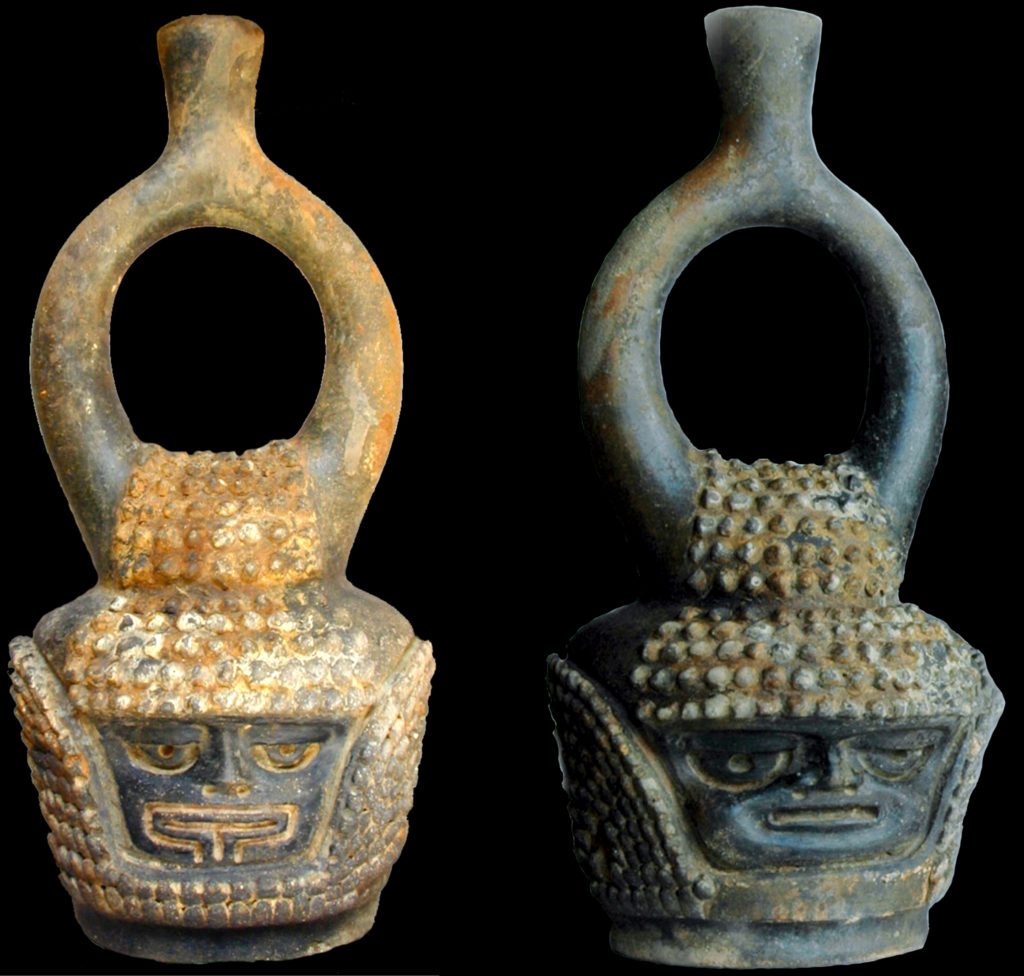
Ministry of Culture and Heritage
By 1820, 100,000 quintals were exported for the first time, a figure that would be constantly increasing until 1842 when yellow fever hit the Ecuadorian coast; epidemic in which 5,000 guayasenses and 3,500 manabitas lose their lives, causing cocoa productivity to drop.
The influence of cocoa and its economic power would be undoubted in the early stages of the Republic of Ecuador, in which several presidents of the nation were linked to this activity, including merchant Vicente Ramón Roca, Generals José María Urbina and Francisco Robles., as well as Diego Noboa Arteta, all owners of cocoa plantations of the time.
For the 1890s, production had an unprecedented increase, the quintals (hundredwight) produced went from 372,433 to 578,626 between 1890 and 1899, which represented an average annual growth of 12.3%, formally starting the country’s cocoa boom.
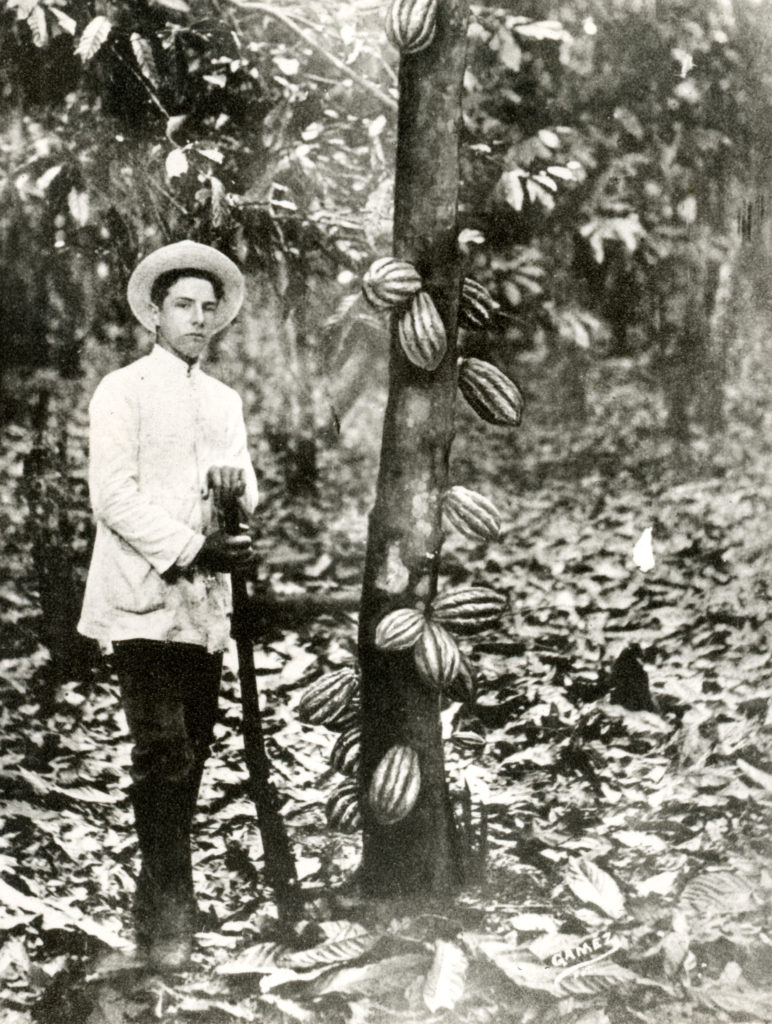
Ministry of Culture and Heritage
Throughout the republican life of Ecuador, cocoa has always been present as one of the star products of the country. It can be highlighted that at the beginning of the 20th century, Ecuador was the world’s leading exporter of cocoa, a situation that was diminished by the start of the First World War, which forced the main buyers; European countries, to invest their money in arms to face the war. In addition, the decline in the production and export of Ecuadorian cocoa is considered due to the pests that hit the country’s plantations, such as the monilla (Moniliophtora roreri) and the witch’s broom (Moniliophtora perniciosa).
Despite this, the country did not abandon this crop and today we position ourselves as the third largest cocoa exporter in the world and the first producer of fine or aroma cocoa, thanks to the organoleptic characteristics provided by the genetic characteristics of its materials. The main ones in conjunction with the influence of the different climates and soil levels that Ecuador has, which give this fruit a varied profile of flavors and aromas unique in the world, making it very attractive within the global market.
Flavor Attributes
The aromas and flavors of cocoa, like wine, are influenced by the combination of human, biological and physical factors (terroir), this particular characteristic has made the cocoa of Ecuador unique in the world. Being the center of origin of cocoa has provided a high genetic diversity throughout its territory, in addition to being one of the countries with the greatest geographical and cultural diversity in the world, and therefore an innumerable combination of aromas and flavors has emerged that meet the highest demands of the world market.
From a commercial point of view, five cultivated materials are the most representative:
- Cacao from the National Complex, located in the coastal region, stands out for its intense floral fragrance.
- Cacao Criollo, located in the coastal region, has aromas of dried and tropical fruits, and herbal notes.
- Cacao CCN51, located in the coastal and Amazon region; has strong cocoa flavors.
- Super Tree Cacao, located in the Amazon region; It has notes of red fruits and slightly herbal.
- Cacao Amazónico or Forastero, located in the Amazon region, presents light woody and herbal notes.


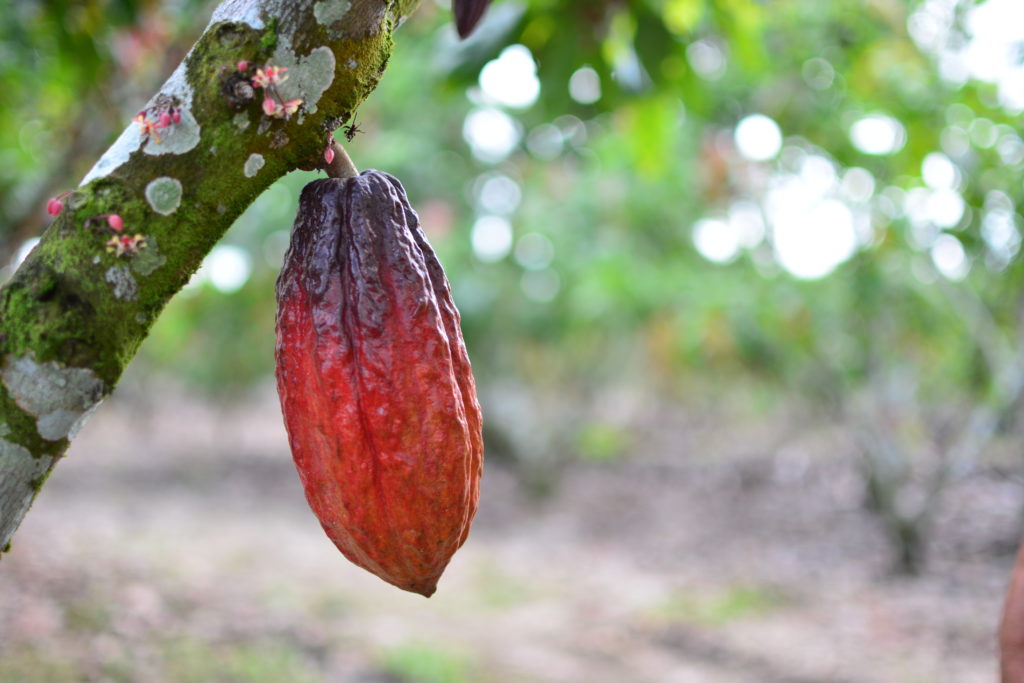
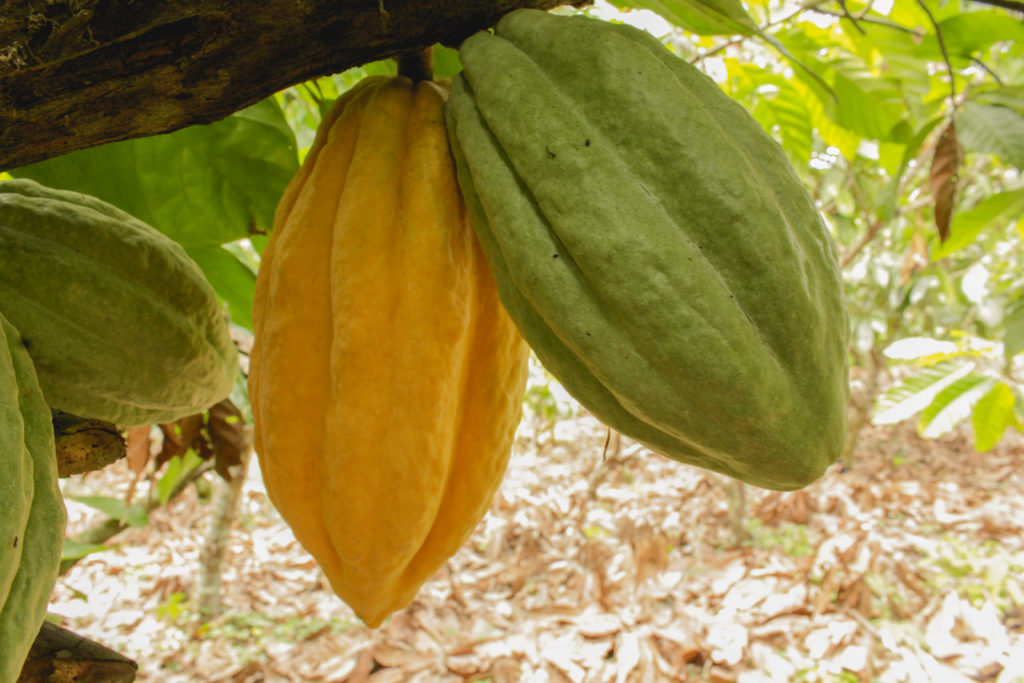
In this way, the chocolates made from these varieties of cocoa, have an exotic mixture of flavors and aromas of fruit, herbs, spices, and especially floral that transport the consumer to the same cocoa farms and have made them worthy of awards and recognitions around the world.
Cultural Practices
In Ecuador, there are knowledge and traditions carried out by the inhabitants of the cocoa territories that have made cocoa an item of great cultural importance. Hence, the oral forms of transmitting knowledge from one generation to another and the daily activities related to the traditional collection, production and consumption processes.
Due to the climatic conditions of Ecuador, cocoa is harvested throughout the year. However, there are two harvest peaks (March-June and October-January) where the highest production is reached (average yield annual is 0.63 t / ha). The harvesting of the cocoa pods of high-rise trees is carried out with poles, long instruments made of cane or other flexible material. In the case of smaller trees, a machete or pruning shears is used. Once the cocoa pods are collected, they are stacked in a specific place within the farm, they are broken and shelled to obtain the slime grain that are transported in plastic bags or buckets to collection centers or sold to intermediaries at the farm. In the collection centers, the grains are fermented in heaps or in wooden crates for 4 to 6 days (depending on the variety, area and customer requirements), then the grains are naturally dried on drying racks for 5 to 8 days, until reaching 7% humidity, maintaining the quality and safety that are controlled by national standards. Finally, the beans are stored in jute bags placed one on top of the other on wooden pallets to later be transported to exporters or national industry (In 2019, around 270 thousand tons of cocoa beans were exported).
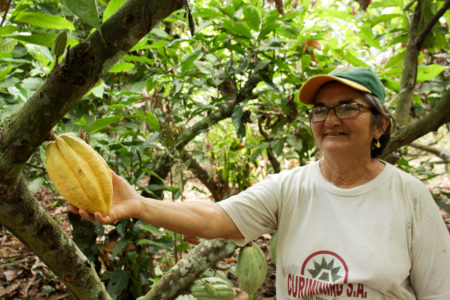
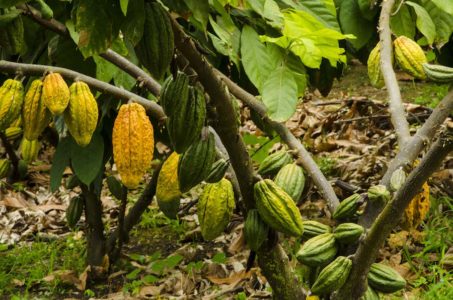
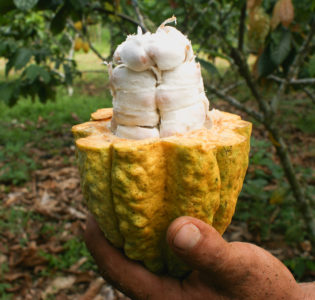
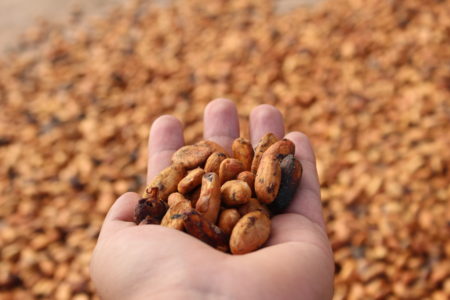
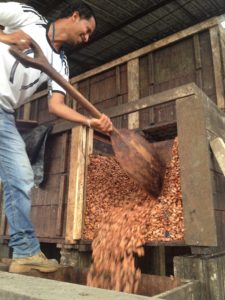
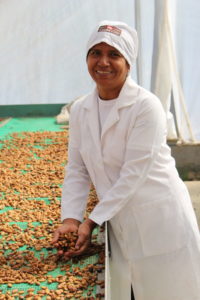
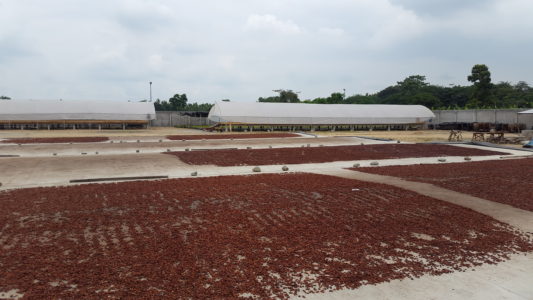
PROYECTO DE REACTIVACIÓN DE CAFÉ Y CACAO NACIONAL FINO DE AROMA
Nowadays, several national chocolate brands have known how to take advantage of the quality of the Ecuadorian cocoa bean, and a reflection of this are the innumerable awards that they have won internationally. However, there are still several cocoa producers that continue to produce artisanal chocolate, by roasting the cocoa beans in wooden pots and constantly stirred with a wooden spoon, then they are ground (stone or homemade mills) until obtaining the cocoa paste. Finally sugar, cinnamon and anise are added.
Social Responsibility
In the social aspect, it is the livelihood of more than 150,000 families that nowadays still preserve the ancestral knowledge of cocoa cultivation and transformation, of which 85% correspond to small producers, who day by day work to provide us with the best cocoa in the world.
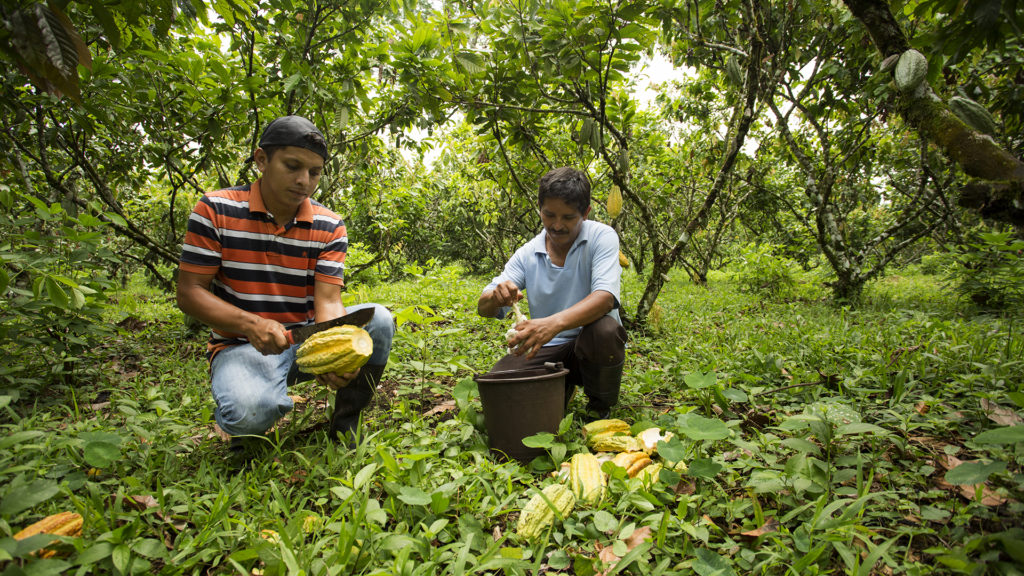
Pictured (left-right): Jefferson Villasmai and Ariolfo García Project: Iniap
Location: Joya de los Sachas – Orellana
PROYECTO DE REACTIVACIÓN DE CAFÉ Y CACAO NACIONAL FINO DE AROMA
In addition to the flavor profiles, we must recognize that the country has international recognition for its production model. Eradication of child labor from cocoa plantations that goes hand in hand with the government’s work to provide quality education to our children, fair working hours, fair wages and benefits, work on the eradication of discrimination and harassment, job security, and gender equality are the main pillars of the Ecuadorian production model.
Behind the production figures of cocoa, there is a social face, which corresponds to the families of producers and those of the different actors associated with the chain.
International Awards
Ecuador has been awarded in the International Cocoa Awards, being recognized as “Cocoa of excellence” in 2010, 2011, 2015, 2017 and 2019, representing the best quality of taste, diversity and the geographical and genetic origins of cocoa beans.
- ICA 2010-Limber Moran, Ecuador
- ICA 2011-David Pastorelli, Sulagro Ecuador, and Catarama Farmers Association
- ICA 2015-Ing. Alicia Encalada Villacis. – CoEx Code -020, and Asociación Agrícola La Fortaleza – CoEx Code -038
- ICA 2017-Quiroga Association – CoEx-Code – 189
- ICA 2019-Costa Esmeraldas Cacao Company – Km 17 via Tonchigue, Muisne, sector 7 de Agosto, Tonchigue, Atacames – CoEx Code-289
Likewise, Ecuadorian chocolate has received important recognitions in the “International Chocolate Awards,” including the following awards:
- Gold 2019
- Dark chocolate bars with inclusions or chunks, Pacari Chocolate (Ecuador)
- Gold 2018
- Pacari Chocolate (Ecuador), Juniper-Enebro Bar
- Organic: Pacari Chocolate (Ecuador) – Raw 85% with coconut sugar
- Gold 2017
- Smooth / Origin Dark Chocolate Bars: Pacari Chocolate (Ecuador) – Tutu Iku 70%
- Dark chocolate bars with infusion or flavorings: Pacari Chocolate (Ecuador) – Cedrón (Lemon Verbena)
- Smooth / origin dark chocolate bars: Organic Pacari Chocolate (Ecuador) – Los Ríos 72%
- Gold 2016
- Dark chocolate bars with infusion or flavorings: Pacari Chocolate (Ecuador) – Menta Andina
- Smooth / origin dark chocolate bars: Producing Country: Pacari Chocolate (Ecuador) – Tutu Iku 70%
- Gold 2015
- Smooth / origin dark chocolate bars, Producing country: Pacari Chocolate (Ecuador) – Raw 70%
- Organic: Pacari Chocolate (Ecuador) – Raw 70%
- Dark chocolate bars with infusion or flavorings: Pacari Chocolate (Ecuador) – Cedrón (Lemon Verbena)
- Whole fruits covered with dark chocolate: Pacari Chocolate (Ecuador) – chocolate covered bananas
- Gold 2014
- Smooth / origin dark chocolate bars: Montubia 70%
- Gold 2013: Smooth / origin dark chocolate bars
- Pacari Chocolate (Ecuador) – 70% Piura-Quemazon
- Gold 2012: 70% Raw – Organic and Biodynamic
- Dark smooth / sourced bars: 70% Piura-Quemazon
- Gold – Chocolate Maker
- Gold – Chocolate growing country
- Gold – Directly traded cocoa
- Gold – Organic
- Best source of cocoa and flavored dark chocolate bars: 60% with lemon verbena
- Dark smooth / sourced bars: 70% Piura-Quemazon
HCP Designees in Ecuador
Certifications
According to the business segment, Ecuadorian cocoa registers globally recognized certifications, such as UTZ, Rainforest Alliance, Fairtrade and Organic. Conventional or commodity cocoa is recognized mainly by UTZ and Rainforest Alliance certifications, and national certification of Good Agricultural Practices that seek sustainable production. The segment of fine aroma cocoa is commonly certified with Fairtrade especially in the European market, as well as organic certification from various countries Germany (Naturland), Switzerland (Biosuisse) and Organic certification from Ecuador. Additionally, the regenerative organic certification, the carbon neutrality seal, and the B certification, are certifications that have promoted the access of cocoa to markets of world demand. In the Premium cocoa segment, the certifications that stand out in addition to the Organic and Fairtrade certifications within special market niches are Demeter, the Kosher certification, and the Chakra seal.
The impact of certifications is measured in cultivated areas, production volume, and number of certified producers or members of a certified organization. In relation to cultivated areas, the UTZ certification leads with 72,000 ha certified, followed by Rainforest Alliance with 27,000 ha, Organic certification with 15,000 ha and Fairtrade certification with a tendency to decrease with an estimated 13,000 ha in 2018. In terms of production volume, again UTZ leads in the country with 83,000 tons in 2017, followed by Rainforest Alliance with 34,600 tons, Organic certification with 5,600 tons and Fairtrade with 3,300 tons. Finally, in relation to certified members, UTZ has certified approximately 8,800 producers, and Fairtrade and Rainforest have certified 3,700 producers and 3,600 producers respectively.
Producer organizations
The cultivation of cocoa is in the hands of 150,000 farmers, who are mostly small producers (1 to 5 hectares), with an average age of 55 years, and around 25% are associated. Ecuador’s production system stands out for not presenting child labor, promoting gender equality through a significant presence of women throughout the cocoa chain, and maintaining environmentally friendly practices.
The organization and cooperation between producers has become a key point in State intervention, as it is a determining factor in the country’s cocoa production. Through the support of different public, private or international cooperation entities, it seeks to promote standardization in quality in organizations, as well as to promote productivity.
By 2020, according to the Ministry of Agriculture and Livestock, in the country there are 431 organizations of cocoa producers, which are located in the Coast region, the Amazon and foothills of the Andes mountain range.
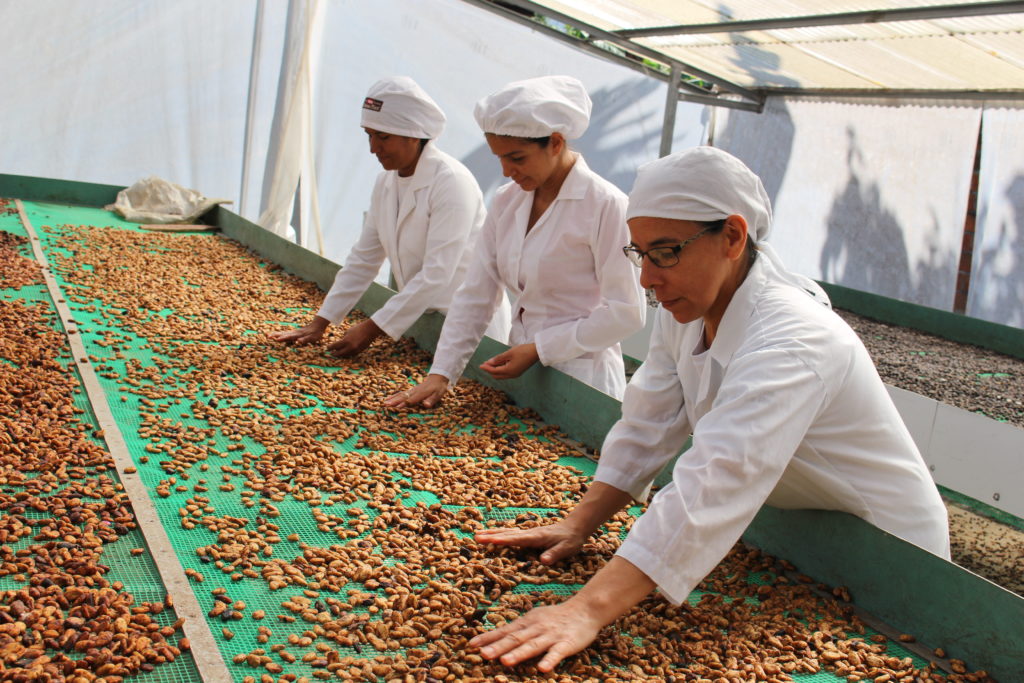

National Fine Aroma Cocoa and Coffee Reactivation Project, Ministry of Agriculture and Livestock
PROYECTO DE REACTIVACIÓN DE CAFÉ Y CACAO NACIONAL FINO DE AROMA
Thanks to their association, organizations have access to:
- Creation of mutual aid and search for synergies
- Generation of individual and collective capacities on issues related to the organization and its production processes (production, harvest-postharvest, quality)
- Development of sustainable and sustainable enterprises or businesses in favor of associates and their families
- Representation before public and private organizations
- Promotion of comprehensive training of associates
Contacts in Country
Patricio Rubio
Project Manager for the National Fine Aroma Cocoa and Coffee Reactivation Project, Ministry of Agriculture and Livestock
Ministry of Agriculture and Livestock
prubio@mag.gob.ec
Francisco Miranda
President, National Association of Cocoa Exporters and Industrialized of Ecuador (ANECACAO)
presidencia@anecacao.com
Union de Organizaciones Campesinas Cacaoteras Unocace
Contact: Cabello Luna Freddy Benito
Location: San Jacinto de Yaguachi, Guayas
Email: cabellofino@outlook.es
Phone: +593 994160229
Fortaleza del Valle Corporation
Contact: Zambrano Velez Berto Pedro
Location: Bolívar, Manabí
Email: fortalezadelvalle@hotmail.com
Phone: (+593) 999078915
Red de Integracion Economica de las Organizaciones Agropecuarias de la Cocpe-Redescocpe
Contact: Moran Jimenez Limber Robinzon
Location: Quinindé, Esmeraldas
Email: gerentecocpe@hotmail.com
Telephone: (+593) 979918734
Asociacion Agro Artesenal de Produccion de Bienes Agricolas, Pecuarios Y Piscicolas de Napo Kallari
Contact: Dahua Shiguango Bladimir Jairo
Location: Napo, Tena
Email: info@kallari.com.ec
Telephone: (+593) 987213955
UOPROCAE-Union de Organizaciones Campesinas Cacaoteras Unocace
Contact: VERA PLAZA JHONNY RAUL
Location: Atacames, Esmeraldas
Email: aplaza34@yahoo.com
Phone: (+593) 997195444
